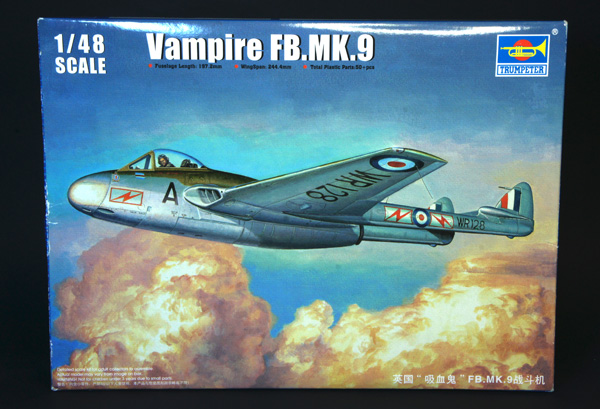
Review by Dave Coward
Background to this build
Two things promoted me to make this kit:
- I wanted an easy build and this was lying at the top of the stash
- Airfix’s new Meteor F8 had just been released and this would make a nice stablemate for that kit (Geoff has a full build of this great-looking kit in the Airfix pages of Finished Now)
I picked the kit up a couple of years ago when it was on offer, the price tag says £9.99, a real bargain at the time!! Upon opening the box, the first thing you will notice is there isn’t a lot in there; three grey sprues and clear sprue with a total of 59 parts (57 grey and 2 clear) so this should be a quick build. There are two markings provided:
- Vampire FB.9, WR128, 502 Sqn RAuxAF, RNAS Sydenham, UK, 1955
- Vampire FB.9, WR996, 32 Sqn, RAF Khormaksar, Aden, 1952
One scheme is camouflage over silver and the other silver so two very different choices.
A quick note here about the accuracy of the kit. The first major point is it isn’t an FB.9 as advertised as it is missing a very prominent A/C unit just in front of the right intake but it will build into an FB.5 or 4 but you will need aftermarket decals. There are also a lot of questions over the accuracy of its shape but to me it looks like a Vampire – good enough for me. My plan is to build it straight form the box, decals included!! Rivet Counters take a deep breath!!!
A little bit of background to the De Havilland Vampire
The de Havilland Vampire is a British jet fighter developed and manufactured by de Havilland. Having been developed during the Second World War to harness the newly developed jet engine, the Vampire entered service with the Royal Air Force (RAF) in 1945. It was the second jet fighter, after the Gloster Meteor, operated by the RAF, and its first to be powered by a single jet engine.
The RAF used the Vampire as a front-line fighter until 1953, when it was given secondary roles such as pilot training, although 103 Flying Refresher School had them deployed in that role from 1951. It was retired by the RAF in 1966, replaced by the Hawker Hunter and Gloster Javelin. It achieved several aviation firsts and records, including being the first jet aircraft to cross the Atlantic Ocean. The Vampire had many export sales and was operated by various air forces. It participated in conflicts including the 1948 Arab–Israeli War, the Malayan emergency and the Rhodesian Bush War.
Almost 3,300 Vampires were manufactured, a quarter of them built under licence in other countries. The Royal Navy’s first jet fighter was the Sea Vampire, a navalised variant which was operated from its aircraft carriers. The Vampire was developed into the DH.115 dual-seat trainer and the more advanced DH.112 Venom ground-attack and night fighter.